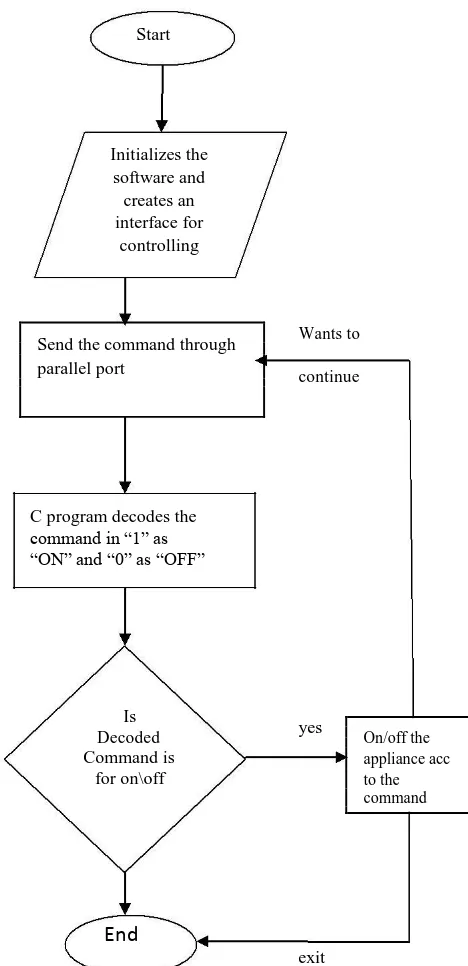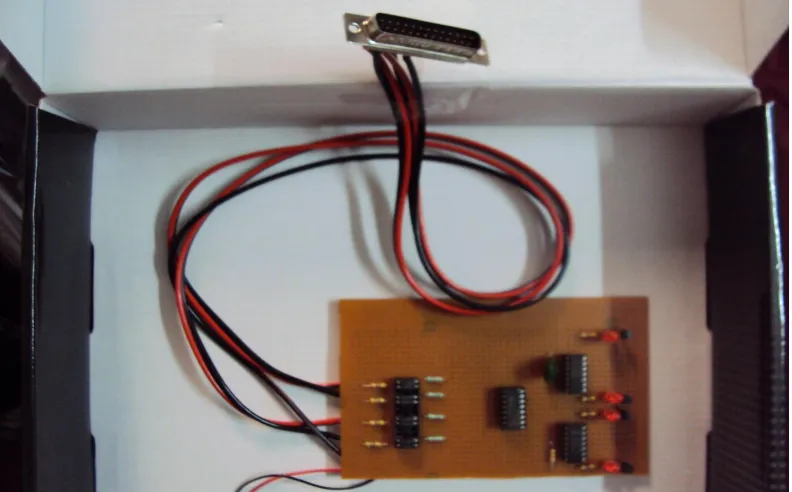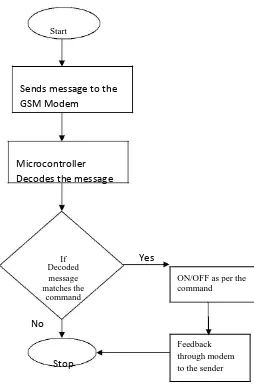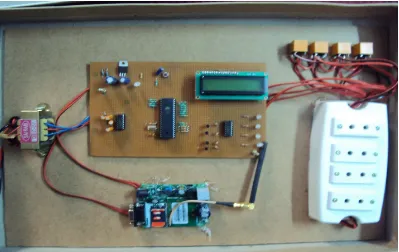Controlling Electrical Appliances through PC and GSM
Technology
Shivanka (Priyanka
Ashu Grover
Nikhil Arora
Chugh)
GGSIPU GGSIPUGGSIPU Maharaja Surajmal HMR Institute of Technology Maharaja Surajmal Institute of Technology, New and Management, New
Delhi, India Delhi, India Institute of Technology, New
IT Department CSE Department Delhi, India
IT Department
ABSTRACT
In today`s modern world, everybody is becoming dependent on high technology and equipments to make one`s life easier and hassle free. So there naturally arises a need for any person to control the appliances when he is away from his residence or work place for a short period or is touring due to some personal or business purposes at a faraway location and also to reduce the manpower by controlling machineries using the GSM Technology and appliances in industries, factories etc by a human compiled computer based software which cuts off and initiates the functioning on user‘s initiation.Therefore, the system of controlling and monitoring from a remote place becomes all the more necessary. Many products are available in the market which helps us controlling home appliances through internet. Mobiles phones have become a necessity in today`s world, therefore, to find a cost effective and secure solution, mobiles phones are better than any other available solutions. This paper presents PC remote controlling with the Mobile Phone when the user is away from the place.
General Terms
SMS refers to messages by authenticated users thus ensuring a safe and a secure system of appliances control.
Keywords
PC Parallel Port, Global System for Mobile Communication (GSM),Short Message Service(SMS),Micro-Controller AT89s52.
1. INTRODUCTION
These days, whole world has come closer due to many means of communication which are fast and simple. People are using mobiles phones for multi purposes. The objective of this paper is to provide a solution for controlling home appliances from a remote place. These days, everyone is using electrical appliances like refrigerator, AC, fans, microwave oven etc. Moreover, energy bills are skyrocketing and pinching the common people. Therefore, it has become all the more necessary for common man to automate their homes and control electrical appliances from a faraway place. Moreover, safety of house from dangers like short circuiting can also be
This system is implemented by using Short Message Service which is available in all the Mobile Phones and all the mobile Networks. We can use Windows Phone7 [5] application and control home appliances in a friendly environment. By this we can curtail power wastage and thus save a lot of money. Mobile user can control the home appliances even when they are out. Several methods can be developed for controlling PC with mobile phone.
2. RELATED WORK
[1] This paper was all about appliance control via a micro computer based upon 2 different approaches i.e. one was timer option and the second was of voice command. PC Parallel port was in used in the following and the coding of the underlying project was developed in VB 6.0. In this the voice command was converted to text and that further supports the controlling.
[2]Proposed appliance control system via Bluetooth. A remote was prepared under along with a keypad which acted as an interface between the Bluetooth module and the microcontroller. This interface was created so that the remote can communicate easily with the appliances controlling module ,whenever a key was pressed the controller sent the command initiated to the receiver and the receiver will do the required action promptly[7][8].
[4]Proposed home appliances control system using GSM technology under which the appliances were controlled using SMS comprising up of AT commands for on/off of respected appliances. PC parallel port was installed to allocate the control over the appliances installed and a feedback mechanism was also introduced in this which retrieves back to the user about the appliances.
successfully. After the initiation process is completed the authenticated user will be asked for the appliances on/off commands which can be processed by pressing 1 for ―ON‖ and ―0‖ for ―OFF‖ and all the further appliances are assigned their respected positions individually [10].
3. PROPOSED SYSTEM
Based on our study and research on presently ongoing ways to control electrically appliances through PC and GSM,we hereby propose a system for the same with an idea to do the same operation in the best possible manner with low cost involved and maximized outputs. Furthermore it is also ensured that this system will prove fruitful for other advancements in the future with more features and benefits.in addition to it while preparing this system it is also being ensured that this successful is successful in coordinating huge number of appliances successfully in an industry or in any huge organization with less manpower involved and for prompt and safe controlling simultaneously.
3.1 PC INTERFACING SYSTEM
To realise this whole system practically ,we have designed a software which will easily realise our aim of controlling electrical appliances via the system successfully .In order to interface the software with the real purpose of the following application, PC parallel port[1][3] is used as it is used for a swift interface without any disruptions.
The parallel ports pins are based upon TTL level outputs which works on the basis that if the output voltage ranges somewhere between 0 – 0.8V it will consider it logically as 0 and if the voltage range is between 2.4-5 DC volt then the output logically will be 1.A parallel port as in total can support 256 different control signal statuses as it is comprised up of 8 bits for data input/output[7].
The parallel port will receive the signals based on the inputs being done by the user on the software being prepared and the signals will be of approximately 5volts respectively for each switching circuit controlled and thus activated. The voltage as in output will change accordingly the interfacing hardware. This all is realised abruptly with the transistors installation in the mediocre manner with the switching circuit as it gradually helps in completing the switch mode operation. The whole interfacing circuit is connected to the parallel port and it is mandatory to protect the whole system from misuse by introducing a feedback mechanism in order to ensure a error free controlling and cutting off the power wastage gradually and thus ensuring a safe and a prompt way of controlling devices via a computer based software and thus reducing the manpower.
3.1.1 Flowchart
The PC interfacing will start functioning once the program compiled up in the C programming language initiates
Start
Initializes the software and creates an interface for
controlling
Send the command through Wants to
parallel port continue
C program decodes the command in ―1‖ as ―ON‖ and ―0‖ as ―OFF‖
Is
yes
On/off the Decoded
Command is appliance acc
for on\off to the
command
End
[image:2.595.347.581.155.638.2]exit
Figure 1: Flowchart highlighting the whole processs of controlling appliances via PC and how the commands
3.1.2 SCREENSHOT
Figure 2: Screen shots of the output of the program being compiled in the C programming language
[image:3.595.108.504.434.680.2]3.2
GSM
BASED
APPLIANCE
CONTROLLED
With the increasing advancements in science and technology, and increasing innovations of the young mind in the technical fields, there has been a tremendous growth in the present day technologies. In contrast to earlier times , when communication across the globe was almost impossible, but now with the advancement in the telecommunication sector and especially GLOBAL SYSTEM FOR MOBILE COMMUNICATION(GSM) technology communication is just a mere task of fraction of seconds. With further advancements in this technology, controlling electrical appliances via GSM is also feasible just by sending an SMS by the authenticated user to the system installed. This new innovation in this field of controlling electrical appliances directly has been proven successful for wireless control and this technology also supports monitoring the signal strength and has been proven very adaptable.
This whole process of sending a sms to the system installed requires a smooth functioning by a GSM modem installed in the system. This modem readily accepts a sim card which receives the messages from the authenticated users and work accordingly by decoding the same and passes on to the microcontroller GSM modem works just like a cell phone and is attached in a serial combination with the microcontroller which decodes the message accordingly and helps in switching the voltages in the circuits[4].
The microcontroller we have used in this system is 89s52 which maximised the output and ensured a prompt performance of the whole system as this microcontroller can be operational at 33MHz [6] and 4V-5.5V voltage range, withstands 8K bytes of ISP Flash memory with an endurance of 1000 write-erase cycles and supports 256X8bit internal RAM with 32 programmable I/O lines with an interrupt recovery feature at the time of power cut off mode. The whole process of this controlling appliances with the messaging technique is dually stored in the microcontroller via the programmer and the whole code was compiled up in Embed C language for optimum output without any disruptions(FIGURE 4).
The user will initiate the controlling via SMS service by messaging from the authorised number to the number whose sim card[3] is dually installed in the GSM modem and the LED will indicate the appliances in action and whatever changes occurs thereafter[9]. This whole rigorous operation of switching on and off of circuits involves a feedback mechanism dually on LED screen as well as on the authenticated user‘s cell phone viz. what so ever appliance is in operation or switches off ,the indication will be promptly received by the user on his/her cell phone as well as on the LED screen installed in the system.
3.2.1 Flowchart
The GSM based appliance control system will start functioning once the system is ready for application through when the authenticated user sends messages ON or OFF along with the desired switching circuits to be switched on or off. According to the desired command by the user the message will be decoded once received by the GSM modem and then the Microcontroller will further execute the command for final operation. The final operation through the controller is based upon the program being compiled into the same via programmer. This way the simultaneous operations will be carried out with the user controlling appliances using sms service and feedback message will be acknowledged along with the LED indicating the same ongoing processes.
Start
Sends message to the
GSM Modem
Microcontroller
Decodes the message
If
Yes
Decoded
ON/OFF as per the message
matches the command
command
No
Feedback
[image:4.595.321.575.247.632.2]Stop
through modemto the sender3.2.2 MESSAGE OUTCOME ON LED SCREEN
TABLE 1: Commands and Feedback Message when appliances are ON
Appliance no
Message send by the
Feedback Message
user for switching ON
received by the sender
1
ON 1
Appliance 1 is ON
2
ON 2
Appliance 2 is ON
3
ON 3
Appliance 3 is ON
4
ON 4
Appliance 4 is ON
The above mentioned table highlighted the commands and their simultaneous feedback mechanism for switching ‗on‘ the appliances and this way even more number of
[image:5.595.45.519.111.260.2]appliances can be made to function efficiently in a mixed way thereby fulfilling our goal.
TABLE 2: Commands and Feedback Message when appliances are OFF
Appliance no
Message send by the
Feedback Message
user for switching OFF
received by the sender
1
OFF 1
Appliance 1 is OFF
2
OFF 2
Appliance 2 is OFF
3
OFF 3
Appliance 3 is OFF
4
OFF 4
Appliance 4 is OFF
The Above table highlighted the commands and their respected feedbacks for switching ‗off‘ the electrical appliances and this way even more number of appliances
aligned into the system can be controlled effectively and thus helping in realizing our sole aim of controlling appliances via GSM Technology using cellphone
3.3.3 A SMALL HARDWARE IMPLEMENTATION
Figure 5: A small pictographic view of how GSM Appliance control system will look like
.
The following model comprises of a GSM Modem with an in-built sim slot which will receive messages from the authorised user and will decode the message for further operation of controlling the swtching on and off of the respected apppliance installed within this system thus ensuring a swift response.The authenticated user will prompt the system by using Short Message Service(SMS) to the number whose sim card is dually installed in the GSM Modem.The then received message by the GSM modem is decoded and transferred through the serial communicator installed in the system which ensures a complete path for message transfer from the modem to the microcontroller and thereby regulating the voltage for the same through transformer with the inbuilt relays for the switching circuits after the prompt by the already programmed microcontroller[6] installed.The transformer in the system is used to step up and step down the voltage supply in case of increasing or reducing the voltage to the respected switching circuits as per the user‘s command[3][9].This way a command is executed and functioning is realised thereafter of the same
4. CONCLUSION
This paper proposes a very efficient way of controlling electrical appliances via PC and GSM Technology in a remote fashion by creating a generalised interface[7][8],which make the controlling feasible and hassle free through PC and cell phone both. Furthermore this is a low cost controlling mechanism and can be successfully realised at household level and even at larger level in industries or any organisations with larger no. of appliances at a very low cost and in a secure manner.
5. REFERENCES
[1] S. M. Anamul Haque, S. M. Kamruzzaman and Md.Ashraful Islam1 ―A System for Smart-Home Control of Appliances Based on Timer and Speech Interaction‖ Proceedings of the 4th International Conference on Electrical Engineering & 2nd Annual Paper Meet 26-28 , pp. 128-131, January, 2006
[2] Jia-Ren Chang Chien, Cheng-Chi Tai ―The Information Home Appliance Control System—A Bluetooth Universal Type Remote Controller‖ Proceedings of the 2004 IEEE. International Networking, Sensing & Control. Taipei, Taiwan, vol. 1,pp. 399-400, March 21-23. 2004
[3] Mardiana B., Hazura H., Fauziyah S., Zahariah M., Hanim A.R., Noor Shahida M.K., "Homes Appliances Controlled Using Speech Recognition in Wireless Network Environment," ICCTD, vol. 2, pp.285- 288, 2009 International Conference on Computer Technology and Development, 2009
[4] Malik Sikandar Hayat Khiyal, Aihab Khan, and Erum Shehzadi ―SMS Based Wireless Home Appliance Control System (HACS) for Automating Appliances and Security‖. Issue in Information Science and Information Technology Vol 6,, Pp 887-894, 2009.
[5] ChestiAltaff Hussain,K.Vijaya Lakshmi,K.Gowtha
Kumar,K.Siva GangadharaReddy‖ HOME
APPLIANCESCONTROLLING USING WINDOWS 7‖ Issue in International JpiurnalofAdvanced Researchin Electrical,Electronics and Instrumentation Engineering Vol 2, Issue 2,February 2013 pg 817-826
[6] Miss M.A. Tarkunde,Prof. Mrs. A.A.Shinde ―IC TESTER USING 89s52 MICROCONTROLLER‖ Issue in International Journal of Computational Engineering Research Vol . 2,Issue 7,Pg 24-27
[7] Krzyszotf Gajos and Daniel S.Weld.‖Supple: Automatically generating User Interfaces ,―Intelligent User Interfaces,Funchal,Portugal,2004.pp. 93-100
[8] J.Nichols,Myers,B.A.,Litwack,K. ―Improving Automatic Interface Generation with Smart Templates,‖Intelligent User Interfaces,Funchal,Portugal,2004. Pp.286-288.
[9] Dr.B.Ramamurthy, S. Bhargavi ,Dr. R. Shashi Kumar,‖Development of a Low-Cost GSM SMS-Based Humidity Remote Monitoring and Control System forIndustrial Applications‖,Issued at International Journal of Advanced Compuetr Science and Applications,Vol. 1,No. 4,October 2010




